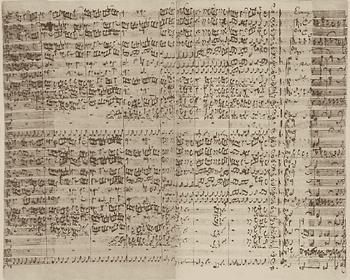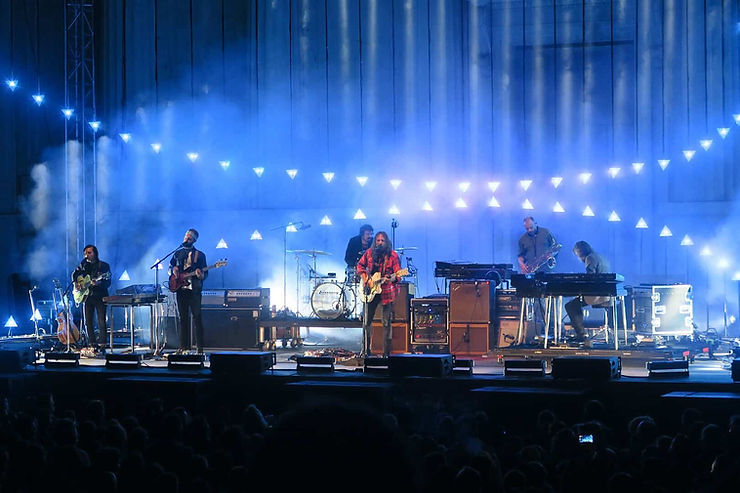Symphony is one of the most sophisticated forms of instrumental music, created in the late Baroque era and continued until today. But what is the definition of “Symphony” exactly?
Classical symphony definition is an extended musical composition in western music, mostly composed in three to six parts or movements for the orchestra. A classic symphony piece has four movements, though from the Romantic era till now there have been many variations to this form and we should also point out that all the composers did not use the four-movement standard.

The beginning of the Symphony
The intro or prologue of an Opera in the Baroque era was named Sinfonia in Italian. This intro was usually a three-part instrumental piece of music. With the growing popularity of instrumental music, composers started to create Concertos.
Concerto is a three-movement piece in which a solo instrument or a combination of three to four instruments, plays the music along with an orchestra. In one of the forms of Concerto, which is named Concerto Ripieno, the whole orchestra plays together.
This type of concerto later changed its form to a four-movement piece, and also changed its name to the previous Sinfonia, and thus the Classical Symphony was born.
Symphony means playing along or playing together!
Classical Symphony
Joseph Haydn is known as the father of Symphony. Though he did not invent the form, he reached the highest quality in the symphony. With 104 symphonies in total, he still holds the record for most symphonies written by one individual.
Leopold Mozart was a great symphonist in his time and he raised a prodigy that we know by the name of Wolfgang Amadeus Mozart today. Wolfgang’s 41 symphonies are amongst the most important pieces in the symphonic repertoire.
Symphony in the romantic era
It was not until Ludwig Van Beethoven that classical symphony saw a vast change in its being. With Beethoven, the symphony was no more a four-part piece of music composed to entertain the audience. It became the best tool for self-expression by the composer. Composers after Beethoven don’t create symphonies just to write nice melodies, Symphony has the same value for a composer as a Novel has for a writer.
Yes, L.V Beethoven is considered a classical composer in many history books. but it does not mean that we should always consider him a classical composer. many of his compositions, especially his symphonies, 3 to 9 are clearly romantic pieces.
With the lead of Beethoven, the Symphony alongside Opera became the most important form of the Romantic era. many composers tried composing symphonies. many just thought about it and never dared. but there was one thing for sure. after Beethoven, no composer looked at the symphony the same way again. no composer wrote 104 symphonies anymore.
The curse of the 9th symphony
Beethoven wrote nine symphonies and died before starting his tenth. with the form being considered a highly sophisticated art form, composers started taking the task of writing the symphony very seriously, therefore the number of symphonies composed by one individual was reduced.
In the romantic era, no famous composer wrote more than nine symphonies. they all died before writing the tenth. Shubert has nine symphonies. Berlioz and Brahms have four symphonies. Bruckner has nine symphonies.
It became known as a curse among romantic composers. any composer who wrote their ninth, well! they kind of were waiting for their death afterward. the story goes that after Gustav Mahler started writing the sketches of his tenth symphony, he told his wife that the curse is broken. it did not take him that long to go to the death bed and leave his tenth symphony unfinished.
The curse was finally broken by Shostakovich, he composed 14 symphonies in total and put an end to the ninth symphony curse!
Program Symphony
Program symphony is a form of a symphony based on a story. In this form, the composer literary acts as a storyteller and gives you drama with the abstract art of music.
Although the first program music can be traced back to Vivaldi’s four-season concertos, the first official program symphony is considered to be Beethoven’s Symphony Number 6, also known as the Pastoral symphony. this piece is in five movements and is based on a narrative story than a classical structure.
Not long after Beethoven’s sixth, Berlioz revolutionized the form of the symphony with his Symphony Fantastique. he changed everything about the form and created a masterpiece that still today sounds modern.
Some great symphonists in the history
there are many symphonists in history. to name a few of them is not fair to many great composers who created a dazzling repertoire of symphonies. but for the sake of the argument, here are some of the most well-known symphonists of all time:
- Ludwig Van Beethoven
- Joseph Haydn
- Wolfgang Amadeus Mozart
- Gustav Mahler
- Johannes Brahms
- Hector Berlioz
- Anton Bruckner
- Pyotr Ilyich Tchaikovsky
- Dimitri Shostakovich
- Franz Schubert

Symphony in the modern era
After Beethoven’s symphony no. 3, not only the form of a symphony but also the whole music has changed. Beethoven made the symphony almost the most important musical form written by composers, and due to their use of the whole orchestra, they make all the harmonic and timber varieties possible for composers.
In our modern era, the symphony has varied even more. many contemporary composers use unconventional instruments to create new timbres in their symphonies. the four-movement structure of the symphony has long gone, and there is no limit on the number of movements and their time!
Of course these days we don’t hear symphonies by contemporary composers that often, even in classical concert halls. but it does not mean that the symphony as a form is abandoned. there are many contemporary symphonies that are worth listening to.
With the vast variety of instruments and harmonic progressions used in today’s pieces, it is almost impossible to consider a specific structure for the symphony. Maybe the best way to consider a piece as a symphony is to refer to its composer and see if they named it a symphony or not.
#symphony #classical_music #music #music_genre #symphonic_orchestra








